Angle grinders are incredibly versatile tools that can be used for a wide variety of purposes – from cutting through metal and stone to polishing up furniture. However, one question that often comes up is whether you can use an angle grinder to grind concrete. Well, the answer is yes! This comprehensive guide will cover everything you need to know about using an angle grinder on concrete, from understanding how it works to tips on how best to tackle your project. Whether you’re new to the world of grinding or have plenty of experience, this guide is sure to have something in store for everyone!
What is an Angle Grinder?
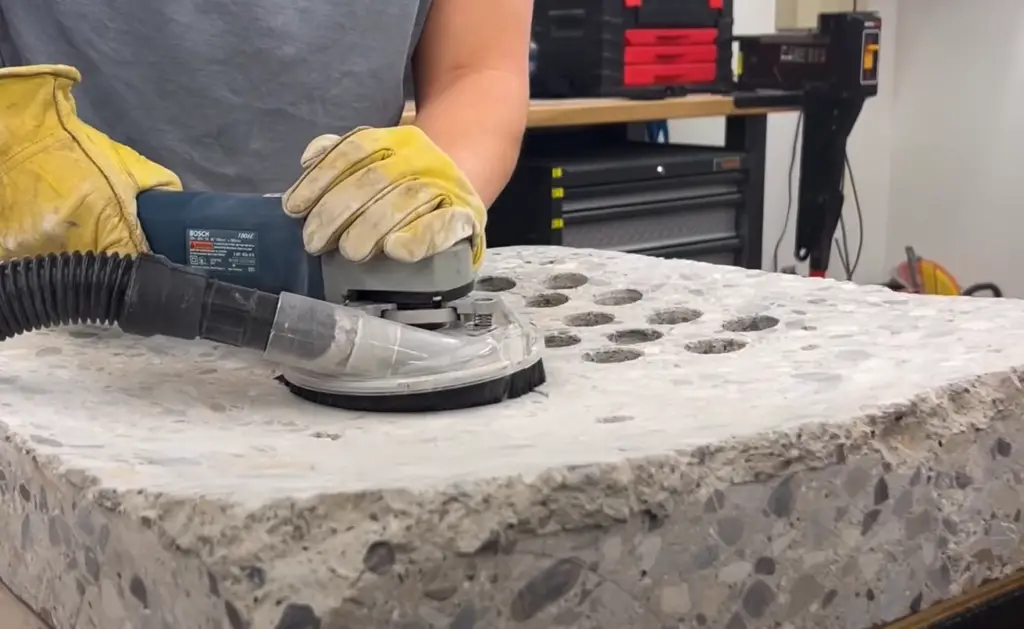
It is highly versatile and can be used for both DIY projects as well as professional applications. Angle grinders come in various sizes and are powered by electricity, compressed air or petrol engines.
The main components of an angle grinder include the motor housing with switch, handle, gear head assembly and spindle lock button. Some models also have interchangeable discs or wheels which allow the user to quickly change between different types of abrasives. Angle grinders offer high speed and powerful performance, making them suitable for a wide variety of jobs including cutting metal pipes, smoothing rough edges, sharpening tools and even sculpting. They are also relatively easy to use and maintain, making them an essential tool for any home workshop.
Safety should be a priority when using an angle grinder; the spinning disc can cause serious injury if used incorrectly or without safety precautions such as wearing protective eyewear, gloves and clothing. With appropriate care and attention, angle grinders can provide you with impressive results quickly and easily. [1], [2], [3]
Can You Grind Concrete With an Angle Grinder?
Grinding concrete with an angle grinder is definitely a good idea. Angle grinders are powerful tools that can easily cut through concrete, making them ideal for removing unwanted sections or repairing damaged ones. However, it’s important to remember to take safety precautions when using any power tool; this includes wearing protective eyewear, gloves and clothing. Additionally, if grinding large areas of concrete then it’s best to use a dust extractor to reduce the risk of breathing in harmful particles.
When using an angle grinder on concrete it’s important to keep the disc moving at all times as this will prevent it from overheating and damaging the material. It’s also important to ensure that you have chosen the correct disc for the job – some are specifically designed for grinding concrete and other masonry materials. Additionally, if you’re using the angle grinder to remove old sealant then it’s best to use a diamond blade as these can easily cut through most types of sealant. [1], [2], [3]
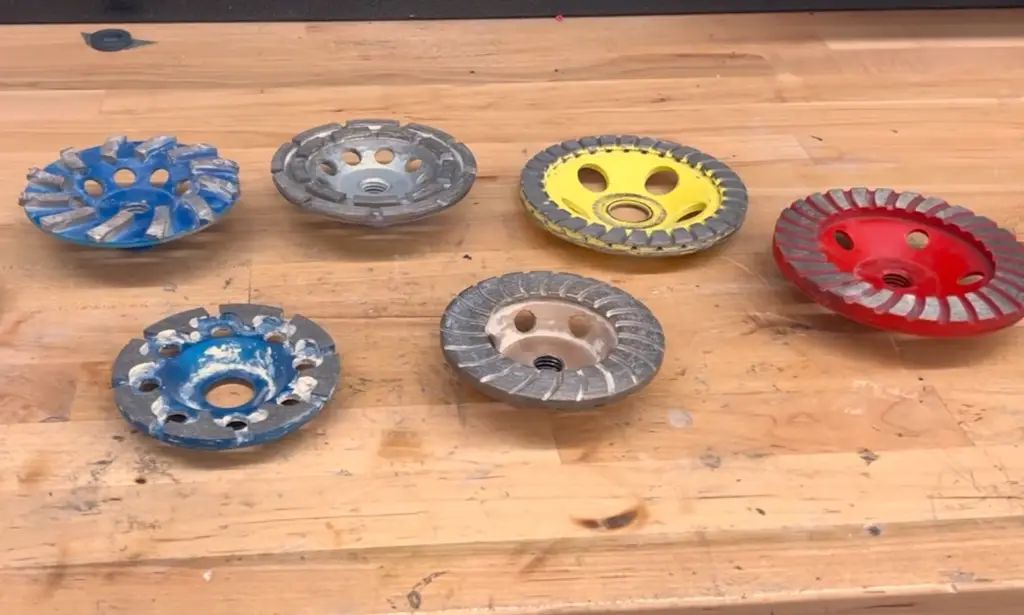
What Types of Projects Are Angle Grinders Suitable for?
Angle grinders are suitable for a variety of projects, such as cutting and grinding metal objects, sanding and polishing surfaces, sharpening tools, removing rust, paint and corrosion from surfaces and more. They can also be used to cut stone or tile, make notches in wood or plastic materials and even sharpen lawn mower blades. Angle grinders are incredibly versatile power tools that can be used for many different applications.
When working on any project with an angle grinder it is important to ensure that you have the correct disc attached and wear proper eye protection. Always use caution when operating an angle grinder and never attempt to perform tasks beyond your skill level. Projects that require more accuracy should be done using alternative methods, such as a band saw or jigsaw.
For larger and more complex projects, angle grinders can be used in conjunction with other power tools to provide the perfect finish. This could include using a router to create grooves in wood before sanding them smooth with an angle grinder equipped with the appropriate disc. By combining different tools, you can ensure that your project is finished quickly and effectively. [1], [2], [3]
Advantages of Using an Angle Grinder for Concrete Grinding
Angle grinders are an incredibly versatile tool, and they can be used for a wide variety of tasks including grinding concrete. In this section, we will look at the advantages of using an angle grinder for grinding concrete.
Small size
One of the biggest advantages of using an angle grinder is that they are small in size, which makes them ideal for grinding concrete. Angle grinders are designed to be compact and lightweight, so they can easily fit into tight areas without having to take up too much space. This makes them perfect for working in confined spaces such as corners or along walls where other tools would not be able to reach.
Easy to use
Another advantage of using an angle grinder is that they are relatively easy to use, even for those who have never worked with power tools before. Angle grinders typically come with detailed instructions that outline how to properly and safely operate the tool. They also tend to be fairly intuitive to operate, so it won’t take long for new users to get the hang of how to use them.
Versatility
Angle grinders are incredibly versatile and can be used for a variety of different tasks in addition to grinding concrete. They can be used for cutting, sanding, and polishing as well. This makes them perfect for tackling multiple jobs with just one tool. In fact, many professional tradespeople choose an angle grinder due to its versatility and ability to quickly and effectively complete a wide range of tasks.
Safety
When using any power tool, safety is always an important factor that must be taken into consideration. With an angle grinder, safety is relatively easy to maintain as the tool has several built-in safety features such as a guard and an emergency shut off switch. Properly following safety instructions when operating the tool will help ensure that no accidents occur.
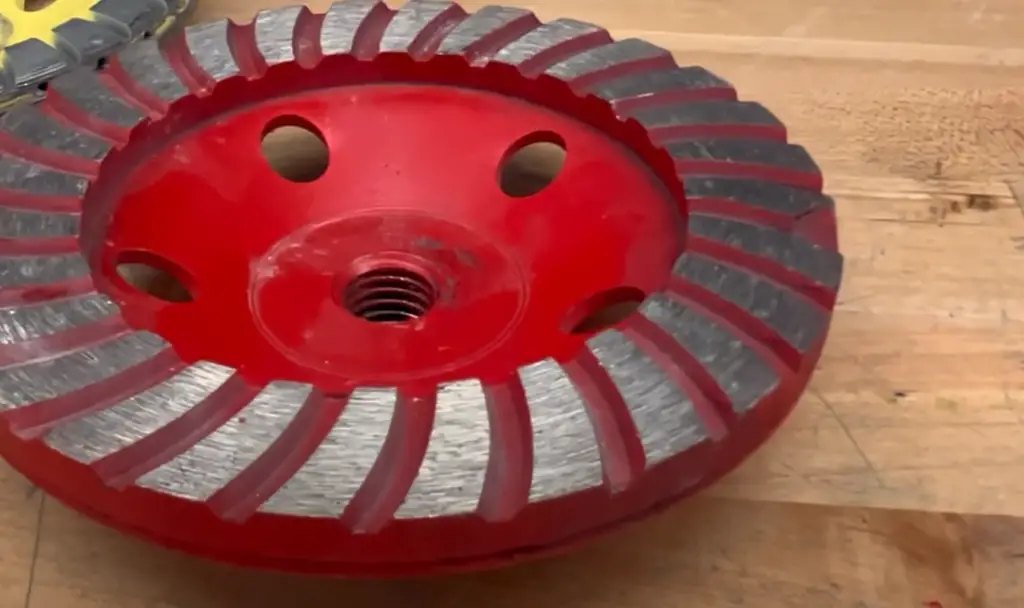
Being grounded into a floor can be a daunting task, but with the right tool and knowledge anyone can achieve a professional-looking finish. Angle grinders provide an easy and effective way to complete this task. With their small size, versatility, ease of use, and safety features they are the ideal choice for grinding concrete. [1], [2], [3]
The Disadvantages of Angle Grinders for Concrete Grinding
Despite all the benefits angle grinders have for concrete grinding, there are some cautions to consider before using this tool. It’s important to be aware of those potential issues to ensure a successful grinding job.
Efficiency
One of the biggest disadvantages of using an angle grinder for concrete grinding is its efficiency. It can take a long time to finish large surfaces with an angle grinder, which can tire out your wrists and cause fatigue.
Angle grinders have subpar cooling capabilities, which means they can overheat easily when used for long periods of time. This can cause the angle grinder to shut down or even fail entirely.
Big blade diameter
While angle grinders by themselves are quite versatile tools, they have one limitation – their blade diameter. The most common angle grinder discs range from 4” to 9” (100mm to 230mm). While this is adequate for many types of grinding projects, it doesn’t provide the same level of detailed grinding as other tools such as a polisher or wet saw may offer.
Dust
Another disadvantage of using an angle grinder for concrete grinding is the amount of dust created during the process. Angle grinders create significant amounts of dust, which can be dangerous if inhaled and irritating to skin and eyes.
It’s important to wear a proper respirator mask and protective eyewear when using an angle grinder for concrete grinding. Additionally, you should ensure that any areas near where you are working are well-ventilated so that the dust doesn’t linger in the air.
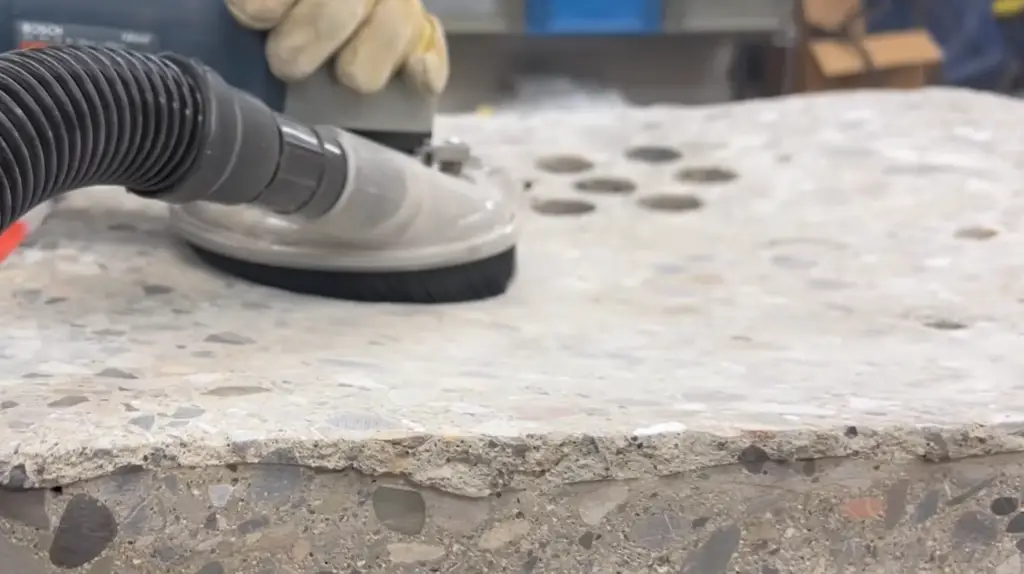
Comfort
When working with an angle grinder, the user is required to grip and support the tool for long periods of time. This can be very uncomfortable, especially if using a larger disc size (7” or 9”). If no rest period is taken during grinding, fatigue can set in which will lead to mistakes. [1], [2], [3]
Safety Considerations While Using an Angle Grinder
Since angle grinders are incredibly powerful tools, they can be dangerous if used incorrectly. Therefore it’s crucial to find out how to use an angle grinder safely.
Keep the kickback in mind
One of the most common causes of injury when using angle grinders is kickback. This refers to the sudden upward motion of an angle grinder when it encounters an object in its path. To minimize the risk of kickback, make sure that you always keep your hands firmly gripped on the handle and away from the disc during operation. Additionally, ensure that you are standing in a steady position with both feet slightly apart for better balance and control.
Read the manual
Before using an angle grinder, it is important to read the instruction manual that came with your particular model. This will provide you with all the information you need on how to safely use and maintain your angle grinder.
Be aware of sparks
Another safety consideration when using an angle grinder is being aware of sparks. Angle grinders create a lot of heat and friction while they are working which can cause metal to spark off in all directions. Protective eyewear should be worn at all times when using an angle grinder to ensure that sparks do not get into your eyes. Additionally, it’s important to wear flame retardant clothing and a face shield if needed.
In the same way, you need to be aware of the dust particles that an angle grinder creates. As you grind, the dust will be propelled in all directions which can cause skin and eye irritation if not properly protected. A respirator mask should always be worn when using an angle grinder to avoid breathing in the dust particles.
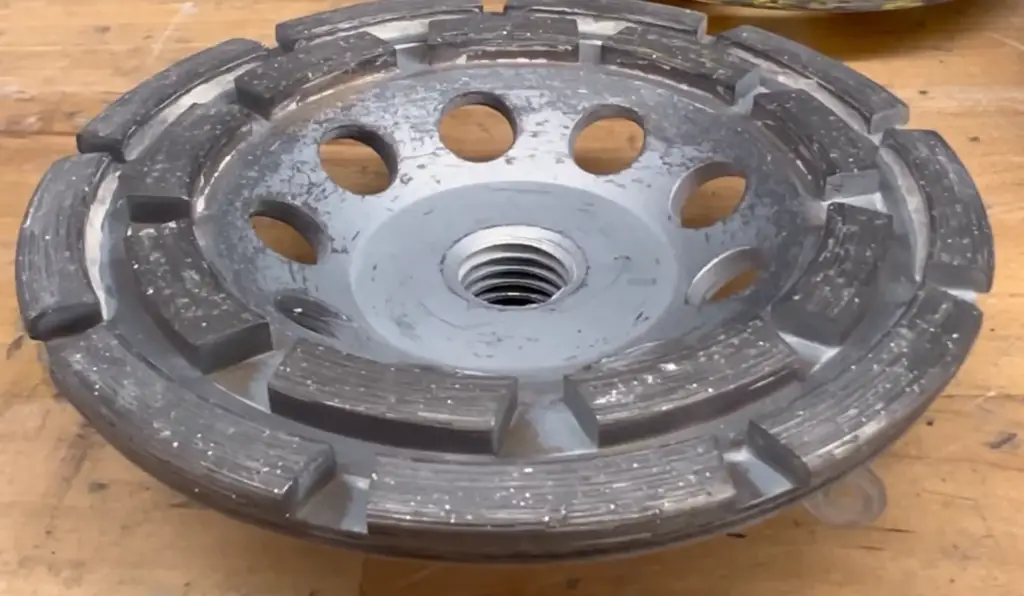
Keep overheating in mind
Finally, it’s important to be mindful of overheating when using an angle grinder. If the tool is used for too long or the disc size is too big, the motor can overheat and shut down. This can cause serious damage to the tool so it’s best to take regular breaks while grinding concrete with an angle grinder. Additionally, make sure that you are using appropriate discs for your specific project and not pushing the tool beyond its capabilities. [1], [2], [3]
FAQ
Can you use a regular grinder for concrete?
No, a regular grinder is not designed to handle the roughness of concrete. Angle grinders are specifically designed for grinding hard surfaces such as concrete and are often equipped with special diamond blades that make them more effective at cutting into concrete. Other specialized tools exist for more specific grinding tasks, but angle grinders remain one of the most versatile options when it comes to grinding concrete.
What is the best way to grind down concrete?
The best way to grind down concrete is with a diamond wheel angle grinder. A diamond wheel grinder is specifically designed to cut through the tough and abrasive nature of concrete efficiently, while still providing a smooth finish. When grinding down concrete, it is important to use the right type of wheel for the job. Diamond wheels are ideal as they create less dust than standard metal blades and are designed not to clog up or overheat as quickly during intense use.
It’s also a good idea to use ear protectors when grinding down concrete, as grinding can be quite loud. Safety glasses should be worn when using an angle grinder on any surface, but especially when working with concrete, in order to protect eyes from dust and debris.
When it comes to the actual grinding process, start by applying pressure evenly as you move the grinder around the surface of the concrete. This will help create a smoother overall finish with fewer imperfections or blemishes in the final product. It’s also important to remember not to press too hard when grinding concrete – it can cause excessive damage and could end up taking more time to repair than if done properly in the first place!
Finally, once your job is finished, keep your workspace clean by vacuuming up any residual dust and debris that remain from grinding down the concrete. This will ensure that no particles get into any nearby electrical outlets or other machinery, which could prove dangerous for anyone working at or near the site.
How do you grind concrete smooth with an angle grinder?
To grind concrete smooth with an angle grinder, start by attaching a belt sander accessory to the grinder. Place the grinder onto the concrete surface and move it back and forth in a circular motion, while applying enough pressure to get even coverage. To achieve a smoother finish, use progressively finer grits between each step until you reach the desired level of smoothness. Additionally, keep your arm steady and hold the blade at roughly 45-degree angles for best results. Make sure to wear protective gear such as safety glasses and gloves when grinding concrete.
Which angle grinder is best for concrete grinding?
The best angle grinder for concrete grinding depends on the size and type of material you are working with, as well as your budget. In general, a 4 ½ or 5 inch angle grinder is suitable for most tasks. If you need to grind larger areas of concrete, then you may want to opt for a 7-inch angle grinder. For smaller jobs such as smoothing out edges or small defects in the surface, a 4 ½ or 5 inch angle grinder should be sufficient. It’s important to consider comfort when choosing an angle grinder – if it’s too heavy or bulky it could cause fatigue while grinding.
What type of angle grinder blade for concrete?
When it comes to grinding concrete, the right angle grinder blade is essential. For most jobs, a diamond blade with a segmented rim is ideal. This type of blade is designed to offer the most efficient performance, with a focus on cutting down time. The segmented rim allows for greater control when grinding concrete, resulting in a smoother finish. Additionally, diamond blades can last longer than other types of angle grinder blades and can be used for multiple projects before needing to be replaced.
Useful Video: How to Grind Concrete with an Angle Grinder
Conclusion
Angle grinders are a versatile and powerful tool for grinding concrete. They can be used to grind down rough edges, shape material, create smooth surfaces, and even cut through hard materials like metal and concrete. With the right angle grinder and knowledge of how to use it safely, you’ll be able to save time on your next project while producing high-quality results.
In this article, we’ve discussed the basics of how to grind concrete with an angle grinder. We’ve covered what type of grinding wheel is best for various applications, how to choose the right angle grinder for your job, and how to use it safely. With this knowledge in hand, you’ll be ready for any project that requires concrete grinding.
Before using an angle grinder on concrete, consider safety measures such as wearing protective clothing and eyewear, using proper techniques such as a wet cutting method with water flow, and following all manufacturer instructions when operating equipment. Grinding concrete requires patience and skill but is definitely worth the effort for any DIYer who wants to achieve professional-looking results. Thanks for reading—we hope this article has been helpful in your grinding endeavors!
References
- https://engineerwarehouse.com/blogs/how-to/grinding-concrete-angle-grinder
- https://www.machinesl.com/grind-concrete-angle-grinder/
- https://paragontools.com.au/grinding-concrete-with-angle-grinder/






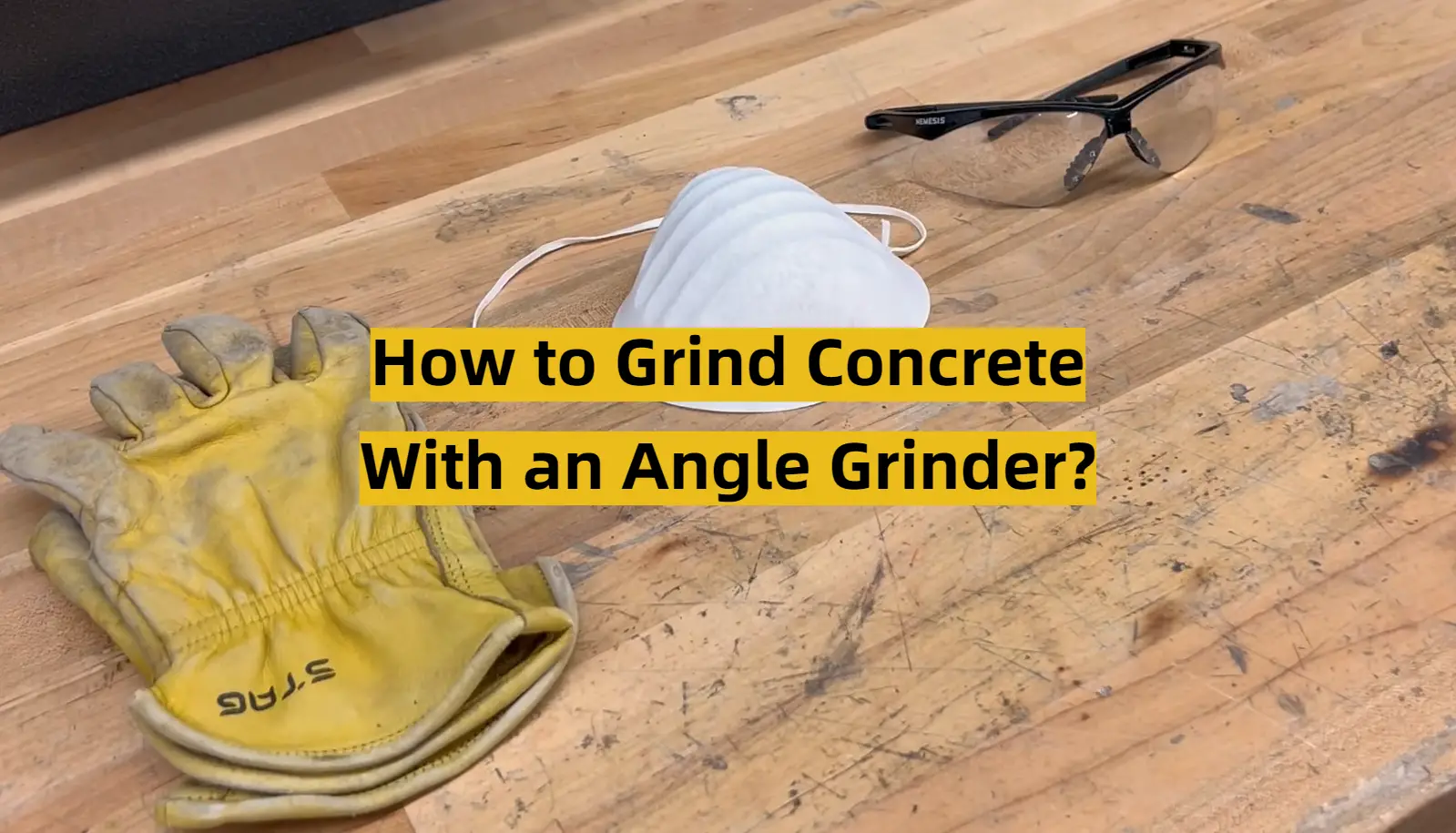




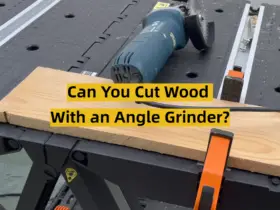
Leave a Reply